HAJJ TASKS AND RESTRICTIONS
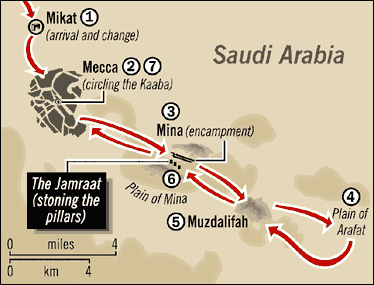 During the Hajj, Muslims spend three to seven days in worship, performing several strictly-defined rituals, most notably circumnavigating the Kaaba (or Qaaba) among millions of other Muslims and the "stoning of the devil" at Mina. The rites are performed between the 8th and the 13th of Dhu al Hijja – the twelfth month of the Muslim calendar. Omar Akour and Ahmed Hatem of Associated Press wrote: The rites of the hajj ”begin in Mecca, the site of Islam's holiest place of worship. There, pilgrims circulate the cube-shaped Kaaba and kneel in prayer facing it. The Kaaba represents the metaphorical house of God and the oneness of God in Islam. Observant Muslims around the world face toward the Kaaba during the five daily prayers. After Mecca, pilgrims spend the day in Mount Arafat before heading to an area called Muzdalifa. There, they will pick up pebbles for a symbolic stoning of the devil and a casting away of sins that takes place in the Mina valley for three days.” [Source: Omar Akour and Ahmed Hatem, Associated Press, August 31, 2017]
During the Hajj, Muslims spend three to seven days in worship, performing several strictly-defined rituals, most notably circumnavigating the Kaaba (or Qaaba) among millions of other Muslims and the "stoning of the devil" at Mina. The rites are performed between the 8th and the 13th of Dhu al Hijja – the twelfth month of the Muslim calendar. Omar Akour and Ahmed Hatem of Associated Press wrote: The rites of the hajj ”begin in Mecca, the site of Islam's holiest place of worship. There, pilgrims circulate the cube-shaped Kaaba and kneel in prayer facing it. The Kaaba represents the metaphorical house of God and the oneness of God in Islam. Observant Muslims around the world face toward the Kaaba during the five daily prayers. After Mecca, pilgrims spend the day in Mount Arafat before heading to an area called Muzdalifa. There, they will pick up pebbles for a symbolic stoning of the devil and a casting away of sins that takes place in the Mina valley for three days.” [Source: Omar Akour and Ahmed Hatem, Associated Press, August 31, 2017]
During the Hajj, Muslims are required to perform the following tasks: 1) On the eighth day of the 12th Muslim month (first main day), at the Sacred Mosque Muslims they must circle the Kaaba seven times, and make seven trips between the hills of Safa and Marwah (both enclosed in a gallery of the Great Mosque). During the former many worshipers try to get close enough to kiss the Black Stone. The latter symbolizes the search for water by Hagar, the slave girl who, according to Muslims, fathered Abraham's oldest son Ishmael.
2) On the second main day (the ninth day of the twelfth month of Dhul Hijjah on the Muslim Lunar calendar) , pilgrims travel to Arar on the Plains of Arafat for the pilgrimage's central ritual: the "Day of Standing," in which Muslims recite Qur’anic prayers all day. 3) On the third main day the faithful go to Mina for three days. Here they throw stones at three pillars representing the devil and celebrate the Feast of the Sacrifice.Before leaving Mecca, pilgrims again circle the Kaaba. If all the tasks are completed the participants receive the title of Hajji, or al-Hajj.
During the 11 day pilgrimage Muslims are forbidden to hunt, argue, shave, cut their hair or nails, wear perfume or engage in sexual relations. Fasting is not required. Pilgrims are also forbidden from getting angry, which is no mean feat. With so many people participating in the Hajj sometimes great patience is needed to get through it. Normal habits are restored after the sacrifice at Mina.
The kissing of the Black Stone in the Kaaba and the stoning of the pillars that represent the Devil at Mina are not essential duties of the Hajj but are have traditionally been performed along with the required tasks. Visiting Muhammad’s tomb at the Prophet’s mosque in Medina is not included in the pilgrimage but it is frequently combined with it.
See Separate Articles THE HAJJ: ITS HISTORY, MEANING AND THE EXPERIENCE OF DOING IT factsanddetails.com ; HAJJ NUMBERS, LOGISTICS, INFRASTRUCTURE AND SECURITY factsanddetails.com ; HAJJ DISASTERS, FIRES AND PROBLEMS WITH THE SATAN STONING SITE factsanddetails.com ; NARRATIVES OF THE HAJJ factsanddetails.com ; JOURNEY TO THE HAJJ factsanddetails.com
Websites and Resources: Islam IslamOnline islamonline.net ; Institute for Social Policy and Understanding ispu.org; Islam.com islam.com ; Islamic City islamicity.com ; BBC article bbc.co.uk/religion/religions/islam ; University of Southern California Compendium of Muslim Texts web.archive.org ; Encyclopædia Britannica article on Islam britannica.com ; Islam at Project Gutenberg gutenberg.org ; Muslims: PBS Frontline documentary pbs.org frontline
RECOMMENDED BOOKS:
“Hajj & Umrah: Journey of Life Time - A Complete Guide for Hajj & Umrah”
by Fisabilillah Organization Authenticate Ulama's Organization Amazon.com ;
"Hajj & Umrah: A Practical and Spiritual Guide to the Journey" by Mustafa Umar Amazon.com ;
“Hajj and Umrah Made Easy” by Taqi Hashmi Amazon.com ;
“Companion of Hajj: Your Step by Step Guide to Perform Hajj Correctly” by Mufti Ikram Ul Haq Amazon.com ;
“Getting the Best Out of Al-Hajj (Pilgrimage)” by Abu Muneer Ismail Davids Amazon.com ;
"The Hajj: Muslim Pilgrimage to Mecca and the Holy Places” by F.E. Peters Amazon.com ;
“Personal Narrative of a Pilgrimage to Al-Madinah and Meccah (Volume I of II)” by Sir Richard Burton Amazon.com ;
“The Autobiography of Malcolm X” Amazon.com ;
“The Haj: A Novel” by Leon Uris Amazon.com ;
“The Siege of Mecca: The Forgotten Uprising in Islam's Holiest Shrine & the Birth of Al-Qaeda”by Yaroslav Trofimov, Todd McLaren, et al. Amazon.com ;
“The Holy Mosques of Makkah & Madinah” by Madiha Ali Amazon.com ;
“Mecca the Blessed, Medina the Radiant: The Holiest Cities of Islam” by Ali Kazuyoshi Nomachi and Seyyed Hossein Nasr Ph.D. Amazon.com ;
“Mecca: The Sacred City” by Ziauddin Sardar, Amerjit Deu, et al. Amazon.com ;
“Islam Beliefs and Teachings” by Ghulam Sarwar Amazon.com ;
“Islam Explained: A Short Introduction to History, Teachings, and Culture” by Ahmad Rashid Salim Amazon.com
Beginning of Hajj
Before the pilgrims begin the Hajj tasks, they enter a state of purity called “ihram” by declaring their intention to perform the Hajj, taking a ritual bath, usually at the their hotel, and putting on their pilgrim clothes. Washing and putting on new clothes before the Hajj are acts of purification and ritual consecration. The humble garb worn by both sexes signifies that whatever their station in life, all Muslims are equal in the eyes of Allah.
 Mecca pilgrims don white “ihrams” , toga-like garment made of two pieces of seamless white terry cloth and sandals. Some men shave their heads. Women wear a loose, ankle-length white dress called a “jibah, “ and a white head scarf. Some of the head scarfs are imprinted with the names of the pilgrim’s tour agency so the pilgrims don’t lose their group. The jihab is often placed over other clothes. It cover everything but the face and hands and resembles a Benedictine nun outfit without the habit.
Mecca pilgrims don white “ihrams” , toga-like garment made of two pieces of seamless white terry cloth and sandals. Some men shave their heads. Women wear a loose, ankle-length white dress called a “jibah, “ and a white head scarf. Some of the head scarfs are imprinted with the names of the pilgrim’s tour agency so the pilgrims don’t lose their group. The jihab is often placed over other clothes. It cover everything but the face and hands and resembles a Benedictine nun outfit without the habit.
Pilgrims often don the their ihrams at the airport in their home country before catching their flight to Mecca to show they are on the Hajj. Many wear sandals and carry money belts and bags. Some carry a green and white umbrella for protection from the sun. Normal clothes are donned after the sacrifice at Mina.
The Hajj formally begins when the millions of faithful who have gathered in Mecca recite the “Talabiyah” in unison:
” Here we come, O Allah, here we come!
Here we come. No partner have You
Here we come! Praise indeed, and
blessings, are Yours — the Kingdom too!
No partner have You.”
Kaaba
The Kaaba (also spelled Ka‘ba) is a huge black box of cleansed of idols by Muhammad during his triumphnat return to Mecca, an act as important to Muslims as the crucifixion of Christ is to Christians. Each year millions of Muslim pilgrims descend on Mecca for the Hajj to the relive the cleaning of the Kaaba and other events central to Muslim faith. In ancient times members of caravans and trade fairs and pilgrims payed a fee to see the 360 idols in the Kaaba, which including an image of Uzza (the Arabian version of Aphrodite) and representations of celestial gods for the moon, sun and morning star from ancient Sheba.
Today the Kaaba lies at the center of Harram Mosque in central Mecca, one of Islam's holiest shrines. Also known as the Sacred Mosque or the Great Mosque, it is comprised of a perimeter of buildings that surround a massive courtyard and a gallery that encloses the hills of Safa and Marwah, where it is said Abraham's servant and lover, Hagar, searched for water for her son Ismail. At the center of the massive courtyard is the Kaaba, the House of God, Islam’s holiest object. When Muslims bow to Mecca five times a day this is where their prayers are directed. During the hajj pilgrims enter the courtyard through the outer buildings at the Gate of Salvation.
The Kaaba is brilliantly lit at night. Some say the best time to visit it is around midnight when you can quietly sit in the steps in the courtyard and reflect upon it, You won’t have it to yourself. Even late at night people gather around it. Around this time you can hear the faithful murmuring prayers and smell the scent of detergent is in the air from the soap used to wash down the marble floor of the courtyard. The Kaaba itself is cleaned with water from the Zamzam well and perfumed with incense, before a new textile covering for the Kaaba is laid.
See Separate Article: THE KAABA: HISTORY, MEANING, PARTS, TRADITIONS africame.factsanddetails.com
Sacred Mosque in Mecca
Harram Mosque (central Mecca) is Islam's holiest shrine. Also known as the Sacred Mosque or the Great Mosque, it is comprised of a perimeter of buildings that surround a massive courtyard and a gallery that encloses the hills of Safa and Marwah, where it is said Abraham's servant and lover, Hagar, searched for water for her son Ismail. At the center of the massive courtyard is the Kaaba, the House of God, Islam’s holiest object. When Muslims bow to Mecca five times a day this is where their prayers are directed. During the hajj pilgrims enter the courtyard through the outer buildings at the Gate of Salvation.

Pilgrims gather around the Kaaba at al-Haram Mosque
The original structure was begun in the 8th century and reconstructed by the great Ottoman architect Sinan (1490-1588). In the 1960s a $100 million, 15-acre addition was added that completely surrounded the courtyard. Later more money was spent to double the mosque’s floor space to over 3.5 million square feet with the construction of a four tiered area that could handle two million people on the first day of the hajj. No mosque is allowed to have more minarets than the Sacred Mosque and according to one story a seventh minaret was added by the Ottoman Turks so that the Blue Mosque in Istanbul could have six.
The Great Mosque is now an air- conditioned super complex dominated by Egyptian-style, neo-Ottoman Empire structures built in the 20th century, with octagonal minarets and granite and marble walls. High-tech additions include domes that open and close according to the weather and huge mechanical umbrellas that provide shade. Few people are allowed to climb the 100-meter-high minarets for a look. A wide avenue leads to the mosque. There is large square around the mosque lined with shops and hotels. People enter the mosque through enormous outer galleries beneath two towering minarets.
Seeing the Kaaba
The Sacred Mosque is Islam's holiest shrine. During the Hajj, pilgrims enter the large open courtyard of the mosque through the Gate of Peace (also known as the Gate of Salvation). In the center of the courtyard is the Kaaba. As the pilgrims enter the “haram” , the sacred area around the Kaaba, they exclaim “”Labbayka! “Labbayka!””—“I am at your service!”).
Reshma Memom Yaqb wrote in the Washington Post: “It’s nearly otherworldy to walk up the nucleus of your faith, to be in the first ten rows of worshippers facing the Kaaba, know there are 1.2 billion Muslims worldwide who are praying in concentric circles, behind you.”
“I came suddenly dazed," recounted Muhammad Abdul-Rauf, the director of the Islamic Center in Washington, when he first laid eyes on the Kaaba. "My wife clung to my arm trembling and sobbing...my daughter shuddered as if an electric current had shot through her, and my son was speechless. He latter told me he was struck by deep feelings of sweet tranquility."
Saleena Nurmohamed, who undertook the Hajj in 2006, at the age of ten, wrote: "I made my way inside cautiously, not wanting to set my eyes on the Kaaba (House of God) until I was able to get a clear and unobstructed view, in order to properly savour the moment. I also wanted to pray for three things dear to me as prayers get granted when you first cast your eyes on the Kaaba. Words cannot describe the emotions that are created when one looks at the Kaaba, such a simple object structurally yet so majestic and awe-inspiring that it is difficult to take your eyes off it. After emotionally gathering myself, I started my Pilgrimage.” [Source: British Museum =]
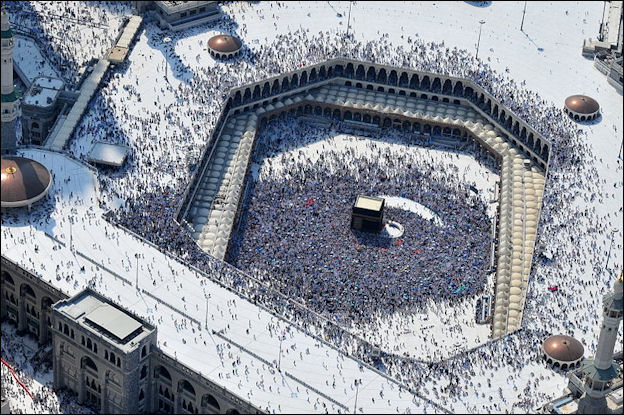
Tawaf: Circling the Kaaba
Tawaf (Circumambulation) is a key element of the Hajj rituals. Performed seven times around the Kaaba anti-clockwise, starting from the eastern corner in which the Black Stone is embedded. The tawaf al-wada‘, the farewell tawaf, is the last rite of Hajj. [Source: British Museum]
Peter Sanders wrote in the nid-1990s: “The Kabah is the world’s sun whose force attracts you into its orbit. You have become part of this universal system. Circumambulating around Allah, you will soon forget yourself. You have been transformed into a particle that is gradually melting and disappearing. This is love at its absolute peak =
“‘Ali Shariati (1933–75) wrote: “Tawaf means circumambulation and in this, the first of the rituals of Hajj, pilgrims walk anticlockwise around the Kaaba seven times. This tradition goes back to the time of Ibrahim (Abraham) and Isma‘il (Ishmael), who walked around the Kaaba seven times after they had rebuilt the structure. Pilgrims undertaking tawaf are following in the footsteps of the prophets Ibrahim, Isma‘il and Muhammad.”
Tawaf in The Miscellany of Iskandar Sultan (813-4/1410-1, Shiraz, Iran) is a manuscript produced at the court of Iskandar Sultan, great patron of the arts, grandson of Tamerlane and ruler of the province of Fars in south-west Iran (1409 –1414). The illustration is from a text on Islamic jurisprudence about the restrictions on a pilgrim when in the state of ihram. Depicted on the left is a dense concentration of pilgrims in ihram surrounding the Kaaba. The sanctuary and the city are enclosed behind a high wall. Angels hover above the Kaaba. To the right a pilgrim caravan approaches the city. During Iskandar Sultan’s rule, manuscripts of great refinement were made in the royal atelier at Shiraz. The other texts in this volume comprise a selection of religious and lyric verse and treatises on astronomy, astrology, geometry and alchemy. The Sanctuary at Mecca and the rite of Tawaf from the Futuh al-haramayn by Muhyi al-Din Lari. (16th century, Iran)
In the early 16th century Muhyi al-Din Lari (d.1526) composed a guide in Persian verse for pilgrims to Mecca. Known as Futuh al-haramayn (Revelations of the Two Sanctuaries), the manuscripts contain colourful illustrations of places of interest in and around the holy cities. These are stylised rather than strictly accurate representations. A good number of manuscripts survived, at least twelve of which have colophon inscriptions indicating that they were produced in Mecca itself and could have been acquired by pilgrims as souvenirs.
The occasion of arriving to the holy sanctuary inspired these verses:
What I have experienced from seeing that sight
is a mystery that I am unable to divulge.
My heart became drowned in the Ocean of Meeting;
I was lost to myself in the glory of Beauty.
It made me bewildered, amazed, stupefied;
the house of my being parted from its foundation!
Crying out, I made for the place of tawaf;
dancing, I came forward for my circumambulation.
His infinite generosity became manifest
aw as I planted a kiss upon the Black Stone –
revolving, circling, and full of presence
I became a moth, and He a luminous candle.
Translated by Muhammad Isa Waley (The Art of Hajj, 2012)

Circling the Kaaba During the Hajj
There are specific rules prescribed for pilgrims in regard to circling the Kaaba. Barefoot, the pilgrims make the “tawaf,” seven counterclockwise circuits around the Kaaba, on the “Mataf” , the marble and pavement around the shrine. Pilgrims may kiss, touch or approach the Kaaba during the pilgrimage as a sign of their respect and continued devotion. On each circuit they try to touch the black stone or at least point in its direction, while chanting in Arabic: “O mighty Allah. This mosque is your mosque. This peace is your peace. This slave is your slave.” Each time the black stone is approached they shout “”Allaahu Akbar” !” (“God is Greatest!”).
After entering the courtyard of the Great Mosque, pilgrims are swept up into a slow moving current of humanity. Thomas Abercrombie wrote in National Geographic, “Bearers carrying the sick and the lame, jostle us with their heavy wooden litters. My legs and heels were torn by a thousand toenails. Old women, lean Bedouins, bearded savants, husky soldiers, whirled together, pressing and praying. Tears of joy streaked the faces of many, for they were reaching at last the sacred goal of a lifetime.”
It takes about two hours to complete the seven circuits. The Pakistani writer Akbar Ahmed wrote: “In the heat...it is an endurance test, especially for children, because there is always a desperate struggle to reach out and touch the magnificent embroidered cloth, which covers the stone, a youngster could be crushed to death.”
During prayers the pilgrims in the courtyard suddenly stop and pray towards the Kaaba. Describing the view of this from the top of a one of the mosque’s minarets, Abercrombie wrote: “They seemed to form an immense and beautiful Oriental carpet — each tuft a white-clad pilgrim — woven in ever-widening circles around the black stone...The hushed whispers of the crowd rose in a muffled chorus...In unison , all foreheads reverently touched the gravel of the courtyard.”
S'ai: Shuttling Between the Hills of Safar and Marwah
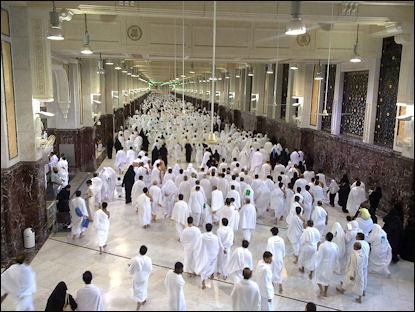
Sayee Afterward circling the Kaaba the pilgrims go through the Bab al-Safa (“Gate of al-Safa”) to perform the S'ai (“sa’y”) by making seven trips between Safar (Safa) and Marwah (Marwa), two small hills, where Abraham's servant and lover, Hagar, searched for water for her and her son Ishmael. She is said to have run frantically between the hills seven times before being guided to a spring by the angel Gabriel. The two hills are nearly a half mile apart but are enclosed within the Great Mosque. There is a special ramp for wheelchair-bound Muslims to assist them in completing the required seven trips between Safar and Marwah.
Pilgrims walk or run between Safar and Marwah to commemorate Hagar's frantic search in the desert for water for her and Ismail. In the midst of her running back and forth, water sprang from the earth, from the well of Zamzam. According to Islamic tradition, both Hagar and Ismail are buried in an enclosed area next to the Kaaba. The area in which the activity takes place is called the mas‘a (the place of hurrying). Qaisra Khan wrote:“The ritual of sa‘i commemorates the Prophet Abraham’s wife Hagar’s search for water, after she was left in the desert by Ibrahim (Abraham) as a test of faith. Having exhausted her provisions, Hagar desperately ran seven times between the mountains of Safa and Marwa searching for help. On returning to her son Isma‘il (Ishmael), she found that a spring of water had gushed out of the ground. This spring is known as the "Well of Zamzam". During sa‘i pilgrims run and walk along a passageway on the eastern side of the sanctuary. The strenuousness of this exercise demonstrates the commitment that is required to live a life according to Islam. [Source: British Museum =]
Suhaib Albarzinji wrote in the Washington Post: “Men and women from every race and nationality and all ages were there — and I was in the middle of it all, packed in so tightly that I couldn’t lift my arms. I felt exhilarated. Everyone was sweating, crying, pleading in prayer. I was surfing a spiritual current that has been flowing for more than a thousand years.”
For some the police presence seems minimal. On his experience Akbar wrote: “It was a pleasantly warm night and a cool breeze blew. There was a constant murmuring of prayers. Water carriers, sweepers, cleaners hovered, but there was no police, nor marshals, no signs of authority. None of the hysteria and wild disorder, which so often mars great religious occasions in Pakistan, Bangladesh and India.”

Sayee for older people In on "The way of performing sa‘i" Muhyi al-Din Lari writes:
You have gained your desire from the stage of tawaf
Move on soon to the Mas‘a to perform Sa‘i
Turn away from the House to the Gate of Safa;
go to Safa and climb up the steps to the top.
See the arch of Safa, like the vault of the skies,
with troops of angels up above it in lines…
Face towards the side holding His Black Stone,
back to the mount of His eternal generosity:
The mount of Safa its head raised up to the sky,
its height that of the sun’s and moon’s rising-points…
Descend quickly, then head towards the Mas‘a;
come into the valley, without your head or feet.
The Messiah’s feet will do the walking for you.
How could the wings of the angels reach your dust?
Start shuttling to and fro – such a coming and going
as gained for men that which angels never won…
Marwa is to one side, Safa to another;
the performer of Sa‘i must be true to his word.
Translated by Muhammad Isa Waley (The Art of Hajj, 2012)
After finishing their tasks at the Great Mosque pilgrims head to Mina to spend the night in prayer and meditation and sleep under the stars in preparation for the Day of Standing. Many of the pilgrims sleep in fireproof tents. Balloons and flags fly above the tents. Hundreds of security personnel patrol the area; posters warn against loitering. Asian laborers in orange jumpsuits sweep the streets.
Zamzam
The spring said to have used by Hagar and Ishmael feeds the Well of Zamzam, where the faithful splash water on themselves or in some cases douse themselves from head to foot. Some dip their shawls and future burial shrouds in it. Water from the well is bottled and given out free to pilgrims. Trucks carrying it drive throug the streets and pilgrims run up to it and fill their cups from taps.
This spring that Hagar found when she was searching for water, after she was left in the desert by Ibrahim is known as the "Well of Zamzam". Drinking from the well of Zamzam forms part of the rituals of Hajj. In Jami‘ al-tawarikh (Compendium of World Chronicles), Rashid al-Din wrote: “The well of Zamzam was rediscovered by the Prophet’s grandfather, ‘Abd al-Muttalib. It was revealed to him in a dream: "Where a whitefooted crow pecks on a group of ants, you will know you have found what you were looking for…" They saw a crow pecking on ants. So ‘Abd al-Muttalib dug there… and they first laughed at him, then marvelled at him. And before long he found an overflowing well.’ Illustrated here, ‘Abd al-Muttalib sets off with his son al-Harith and digs where he is told. [Source: British Museum =]
Known in Arabic as ‘Zamzamiyya’, flasks and bottles of Zamzam water were popular amongst pilgrims, who bought them to use on Hajj. Small bottles containing water from the sacred well were often sealed and sold in Mecca. They are still highly cherished by pilgrims today, who take them home as gifts. Pilgrims would also bring their own flasks to Mecca and fill them with Zamzam water which they would use during their Hajj. One example displayed at the British Museum is a Chinese porcelain water flask with leather string and sealing wax, produced in 19th-century China and acquired in Mecca. It still contains zamzam water inside it.=
A Pilgrim’s Leather Flask (18th – 19th century, Ottoman Empire) is a water-bottle made of leather with iron hook and a turned wooden stopper that was used by pilgrims travelling to Mecca probably to fill with Zamzam water. Embroidered on the neck of the bottle is an Ottoman tughra, a calligraphic monogram, seal or signature of an Ottoman sultan. =

Zamzam well
Wuquf ‘Arafat: Day of the Standing
The most important ritual of the Hajj is the Wuquf ‘Arafat, or "Day of the Standing," when Muslims gather on the Plain of Arafat, and recite prayers under blazing sun from noon to sundown. The ceremony is intended to grant the Muslims absolution from their sins, and if the ritual is missed a pilgrim fails to complete the Hajj. Around the world, Muslims often fast on this day. Wuquf literally means ‘standing’. It refers to the vigil that takes place from noon to sunset on the 9th of Dhu al-Hijja. ‘Arafat is where the Prophet Muhammad gave his Farewell Sermon in 632, the year of his death.
According to the British Museum: At the end of the first day of Hajj (8th day of Dhu al-Hijja) pilgrims will proceed to the tented city of Mina, and camp there overnight. On the following day, they travel to the plain of ‘Arafat. Pilgrims stay at ‘Arafat until dusk, here the pilgrim will stay in contemplation and prayer, an act known as wuquf (meaning standing). This is the most important part of Hajj, where Muslims make their commitment to dedicate themselves to the principles of Islam, which lie behind the Five Pillars. If any pilgrim misses the wuquf, their Hajj is not valid and has to be done again another year. According to Islamic tradition, ‘Arafat is the place where Adam and Eve were reunited following their expulsion from the Garden of Eden. ‘Arafat is also the place where the Prophet Muhammad delivered his Farewell Sermon =
The ritual takes place below Mt. Arafat (Mount Mercy), a gentle hill about 12 miles southeast of Mecca, on the second day of the Hajj. Muslims believe that the last passages of the Qur’an were revealed to Muhammad here during his last sermon delivered from the back of a camel three months before he died in A.D. 632. The plain and the large Masjid Nimra Mosque here are empty throughout the year, except on this one day.
The day’s events begins with an afternoon sermon preached from the “ minbar” , or pulpit, in the Great Mosque of Masjid Nimra or by imam among the multitudes. The pilgrims then travel on foot or by truck, car or bus to Mt. Arafat, where they chant, “Here I am, oh Almighty, here I am.” The standing on Mount Arafat occurs only once every five years during the “greater pilgrimage.”
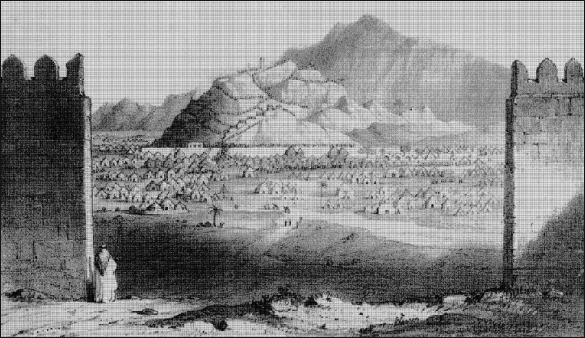
Burton's Mount Arafat
Saudi Arabia’s highest cleric delivers a sermon at Masjid Minra. In 2004, he used the occasionto promote peace and denounce terrorism. He quoted a line from Muhammad’s last sermon—“Know that every Muslim is a Muslim’s brother, and the Muslims are brethren. Fighting between them should be avoided.” and asked “Is it a holy war to shed Muslim blood? Is it holy war to shed the blood of non-Muslims given sanctuary in Muslim nations.”
Muhyi al-Din Lari wrote:
A farsakh, more or less, from Muzdalifa
is an area empty as Non-being itself.
Its expanse is greater than the pilgrims’ hearts
each of whom is now absorbed in his own business.
Though it lies beyond the haram boundaries,
it is the gateway-place for all those caravans.
Enter this area, with full sincerity,
making your supplications, and behold …
Its skirts are filled with the Compassion of God;
around it mankind and angels assemble.
Its shadow betoken the cool shade that God
provides in the courtyards od Paradise.
Though smaller in form that other mountains,
in meaning it is higher than all of them.
Translated by Muhammad Isa Waley (The Art of Hajj, 2012)
Muhammad's Last Sermon
The Prophet Muhammad’s final sermon was delivered during the Hajj of the year 632 C.E., the ninth day of Dhul Hijjah, the 12th month of the lunar year, at Arafat outside Mecca. It is said there were countless Muslims present with the Prophet during his last pilgrimage. Muhammad’s farewell pilgrimage to Mecca is one of the most significant historical events in the minds of Muslims, for it was the first and last pilgrimage made by Prophet Muhammad, as well as being the model for performing the fifth pillar of Islam, the Hajj.
Omar Akour and Ahmed Hatem of Associated Press wrote: “In his sermon, the prophet called on his followers to repay their debts, beware of Satan, perform five daily prayers, fast during the month of Ramadan and give to charity. He also called on those with the means to perform the hajj once in a lifetime. He also reminded worshippers of the rights that women have, and said that no ethnic group or race has superiority over another except in piety and good action. [Source: Omar Akour and Ahmed Hatem, Associated Press, August 31, 2017]

Mount Arafat
Muhammad’s Last Sermon, delivered on the Ninth Day of Dhul Hijjah 10 A.H in the Uranah Valley of Mount Arafat, goes: "O People, lend me an attentive ear, for I don't know whether, after this year, I shall ever be amongst you again. Therefore listen to what I am saying to you carefully and TAKE THIS WORDS TO THOSE WHO COULD NOT BE PRESENT HERE TODAY.
“O People, just as you regard this month, this day, this city as Sacred, so regard the life and property of every Muslim as a sacred trust. Return the goods entrusted to you to their rightful owners. Hurt no one so that no one may hurt you. Remember that you will indeed meet your LORD, and that HE will indeed reckon your deeds. ALLAH has forbidden you to take usury (Interest), therefore all interest obligation shall henceforth be waived...
“Beware of Satan, for your safety of your religion. He has lost all hope that he will ever be able to lead you astray in big things, so beware of following him in small things.
“O People, it is true that you have certain rights with regard to your women, but they also have right over you. If they abide by your right then to them belongs the right to be fed and clothed in kindness. Do treat your women well and be kind to them for they are your partners and comitted helpers. And it is your right that they do not make friends with any one of whom you do not approve, as well as never to commit adultery.
“O People, listen to me in earnest, worship ALLAH, say your five daily prayers (Salah), fast during the month of Ramadhan, and give your wealth in Zakat. Perform Hajj if you can afford to. You know that every Muslim is the brother of another Muslim. YOU ARE ALL EQUAL. NOBODY HAS SUPERIORITY OVER OTHER EXCEPT BY PIETY AND GOOD ACTION.
“Remember, one day you will appear before ALLAH and answer for your deeds. So beware, do not astray from the path of righteousness after I am gone.
“O People, NO PROPHET OR APOSTLE WILL COME AFTER ME AND NO NEW FAITH WILL BE BORN. Reason well, therefore, O People, and understand my words which I convey to you. I leave behind me two things, the QUR'AN and my example, the SUNNAH and if you follow these you will never go astray.
“All those who listen to me shall pass on my words to others and those to others again; and may the last ones understand my words better than those who listen to me direcly. BE MY WITNESS O ALLAH THAT I HAVE CONVEYED YOUR MESSAGE TO YOUR PEOPLE."
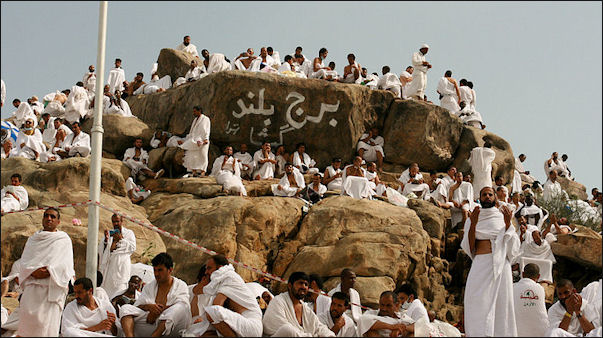
Pilgrims on Arafat
Praying During the Day of the Standing
In the old days many of the pilgrims did their prayers in the scorching sun. It is apparently quite a sight to see two million Muslims on this barren plain all praying in unison. Many cry as they confess the sins they have committed in their lives. One pilgrim said, “They hold up their hands, in supplication, hoping God’s mercy will rain down.”
Abercrombie wrote in National Geographic; “Multitudes packed the sacred hills and plains surrounding Mount Arafat, praying and waiting through the blazing afternoon. Around me the rocky desert landscape shone with white costumes of the pious pilgrim throngs. They stood in silent devotion, as had the prophet Muhammad thirteen centuries before. The white-hot sun slowly quenched itself in the caldron of haze above Mecca.”
These days because of the heat tents are set up all over the plain and most pilgrims do their prayers in the shade of these tents. Many of the tents are carpeted and air conditioned and have large amounts of food and water.
Memon Yaqb wrote: “I stand and bow in prayer...counting my blessings, listing my sins, praying for forgiveness, reciting the Talbiyah. I pray for God to accept my Hajj, and for my life to change as a result of it....This is the time and place where, God willing, the sins I have accumulated...will be forgiven. This is the time and place where God says to his angels, “Why have they come? And the Angels reply, “They come to establish the oneness of God.”
Muzdalifa
At Muzdalifa, pilgrims collect stones to be thrown over several days at the three pillars (jamrat) in the valley of Mina near Mecca. According to tradition, Muzdalifa, situated between Mina and Mount ‘Arafat, is where pardon is granted. Pilgrims collect 49 pebbles if they are to stay in Mina for three days, and 70 pebbles if they are staying for four. The Prophet stated that stones should be neither too big nor too small, approximately the size of a chickpea. [Source: British Museum =]
Peter Sanders wrote: “After leaving the plain of Arafat on the second day of Hajj, pilgrims camp overnight on the rocky plain of Muzdalifa. Here pilgrims gather pebbles that they will later throw at three pillars, known as the Jamarat, situated in Mina. Forty nine pebbles in total are collected to undertake this next ritual which will take place on three separate occasions. The stoning of the pillars re-enacts the story of the Prophet Ibrahim (Abraham) who was confronted by the devil and was ordered by the Angel Jibril (Gabriel) to reject him by throwing stones. This ritual symbolises the destruction of the inner devil.”
Reem Al Faisal wrote: “On the 8th of Dhu al-Hijja, pilgrims camp in Mina before proceeding to ‘Arafat. Also, on the morning of the 10th of Dhu al-Hijja (the third day of Hajj), pilgrims go to Mina to perform the first stoning. Seven pebbles are used here to stone the largest pillar known as Jamrat al-‘Aqaba. Pilgrims spend three or four days in Mina where tents are set up for their convenience. Moreover, between the 11th and 13th of Dhu al-Hijja (Days 4-6), pilgrims return to Mina for further ritual stoning of all pillars after which the Hajj is complete and they return to Mecca for their final tawaf.”

Arafat pilgrims
About Muzdalifa, Muhyi al-Din Lari writes:
This is Muzdalifa, the same territory
you passed through on the ninth day [of the month].
But [this time] its noble splendour catches the eye,
and it shows itself now in a different light
Caravans for which ‘Arafat had no space
will stay for the night at this stopping place.
Tonight it is the oyster-shell for its pearl;
tonight it is the distinction for its star.
Egyptians and Syrians, on all sides,
[camp] in lines around it in deepest respect.
The expanse of this plain is filled, all night,
with colourful tents as far as you can see.
Like roses and tulips, the candles and lamps
make up meadows and gardens, one after another.
Translated by Muhammad Isa Waley (The Art of Hajj, 2012)
Rush to Muzdalifah, Tents in Mina
Precisely at sunset a cannon sounds and all the pilgrims head to Muzdalifah (an open plain between Araft and Mina). Abercrombie wrote: “Sunset was the signal — the spiritual climax of the Muslim pilgrimage. The murmuring prayers of a million souls reached a crescendo. “”Laa ilaaha illa llaah” ! There is no God but Allah!” shout the immense congregation. “He had no partner. He is authority and praise.”...A cannon boomed in the distance. The mountain came to life as a human landslide poured into the valley en route to the next holy place.”
In Muzdalifah, pilgrims perform evening and night prayers and collect pebbles for the next day. They make their way there on foot, in cars, in the back of trucks, on bicycles, packed into buses, on camels. Some call the procession the world’s great traffic jam. Some vehicles take all night to cover the six mile distance.
Memon Yaq wrote: “The pedestrian traffic...is horrific.” Pilgrims “are crammed into cars, vans, buses. And on top of the of cars, vans and buses. Rooftop luggage racks somehow become seats...As my bus lurches forward, I count 30 human beings inside and atop a nearby minivan that would normally seat nine. I watch their lips move as they recite the Talbiyah.”
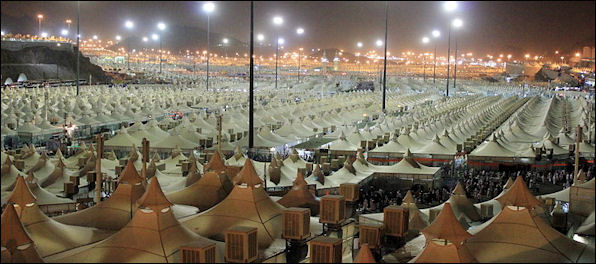
Mina tents
At dawn on the third day of the Hajj the pilgrims move about two and half miles from Muzdalifah to Mina, which is six miles from central Mecca, where they engage in the Day of the Sacrifice and throw stones at the Satan pillars. Mina means “Desires.” A huge tent city is set up for the two million pilgrims who descend on the town. There are miles of tents. They are segregated by sex and uncomfortable. Pilgrims need to bring their own bedding. Some pilgrims stay in tents. Others stay in hotels in Mina. Many sleep in the streets. The toilet situation and sanitation can be nasty.
Casting Satan Stones at Jamarat
At Mina, Muslims throw stones at the “Jamarat “ ("Satan stoning points") that until 2004 were three tall pillars situated in thick-walled basins about 15 feet in diameter and 490 to 738 feet apart. After the 2004 Hajj, Saudi authorities replaced the pillars with 26 meter (85 ft) long walls for safety as many people were accidentally hit by stones thrown from people on the other side. The three pillars in the valley of Mina represent the three times that Satan attempted to tempt Ibrahim (Abraham). They are known as Jamrat al-‘Aqaba (at the narrow pass of al-‘Aqaba, and the largest), Jamrat al-Wusta (the middle one) and Jamrat al-Sughra (the small one).
Situated in valley between mountains of basalt rock, the jamarat represent the devil and the forces of evil and reportedly sit on the spots where the devil tried three times to tempt Abraham into disobeying God while as he took his son to be slaughtered. According to Muslim tradition Abraham stoned Satan at each of the three points before the devil gave up.
The three jamarat are named (starting from the east): 1) al-jamrah al-ula (the first and smallest jamrah; 2) al-jamrah al-wusta (the middle jamrah); and 3) al-jamrah al-kubra or jamrat al-Aqabah (the largest jamrah or jamrah of Aqaba). To allow easier access to the jamarat a single tiered pedestrian ramp called the Jamaraat Bridge has been built around them so pilgrims can throw stones from either the ground level or from the ramp.
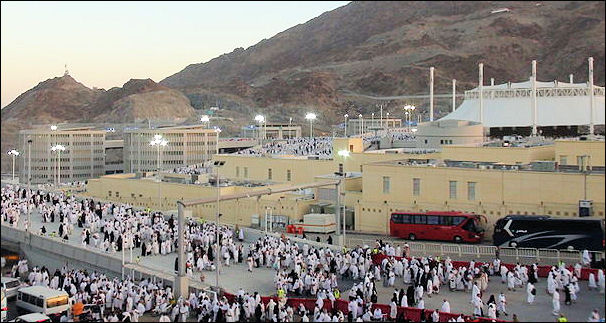
satan stones Jamarat Bridge
Casting stones at the Jamarat symbolizes the lifelong struggle against evil and is a re-enactment of Abraham’s rejection of temptation. The stoning takes place over three days. It used to take place on one day but was stretched to three to handle the crowds. East pilgrim is required to throw at least 49 pebbles. On the first day of the ritual pilgrims must hit the large jamrah only with seven pebbles. On each of the following two days they must hit each of the three walls with seven pebbles, going in order from east to west. Thus at least 49 pebbles are needed for the ritual, more if some throws miss. Some pilgrims stay at Mina for an additional day; in this case they must again stone each wall seven times. The pebbles used in the stoning — which have traditionally been the size of chick peas — are usually gathered at Muzdalifah, on the night before the first throwing, but can also be collected at Mina.
As pilgrims toss the stones many shout “”bismallah” “In the name of God”) and “”Allahu Akbar” — (“God is great"). In 2004, someone scrawled “USA” on one of the pillars and pilgrims shouted out “the greatest Satan” as they hurled the stones. The task has to be performed before dusk. One 30-year-old pilgrim from Somalia told AP, "While stoning the devil I felt I was totally obeying God. I was doing what our master Abraham did."
The stoning ritual is not one of the required tasks of the Hajj. Many Muslim clerics look down on the whole endeavor as un-Islamic. Even so it is done enthusiastically by more than 2 million pilgrims each Hajj and has resulted in scores of deaths (See Hajj Disasters).

casting Satan stones
Eid al-Adha (Day of the Sacrifice)
At the end of the Hajj, the heads of men are shaved, sheep and other halal animals, notably camels, are slaughtered as a ritual sacrifice by bleeding out at the neck according to a strictly-prescribed ritual slaughter methods, to commemorate the moment when, according to Islamic tradition, Allah replaced Abraham's son Ishmael (contrasted with the Judaeo-Christian tradition that Isaac was the intended sacrifice) with a sheep, thereby preventing human sacrifice. The meat from these animals is then distributed locally to needy Muslims, neighbors and relatives.
A great feast throughout the Muslim world, Eid al-Adha (festival of sacrifice) takes place on the 10th of Dhu al-Hijja. Pilgrims sacrifice a sheep (sometimes a goat) as a reminder of the obedience of Ibrahim (Abraham) who accepted to sacrifice his son Isma‘il (Ishmael) as an act of submission before God intervened allowing for a lamb to be sacrificed instead. After the sacrifice, pilgrims shave or cut their hair to mark the end of the consecrated state (ihram) and are allowed everything except sexual intercourse =
The shaving is done with simple scissors and razor. An obligatory ritual is the "taqsir" or "halq" (cutting or shaving) of the hair, which occurs twice during Hajj. The Saudi Arabian government provides licensed barbers with a new razor blade for each male pilgrim, while women snip only a lock of hair. This act of devotion symbolises the shedding of worldly attachments.
See Eid al-Adha Under MUSLIM CALENDAR AND HOLIDAYS africame.factsanddetails.com
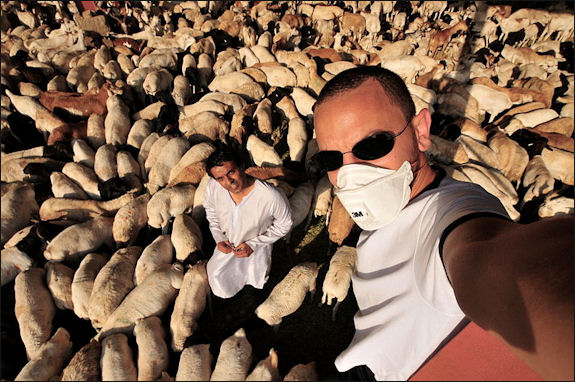
goats to be eaten during the Hajj Eid
End of the Hajj
The Hajj officially ends after the first of the three days of stoning but many pilgrims keep wearing their pilgrim clothes. Before leaving Mecca, they again circle the Kaaba. To mark the end of the Hajj, some Muslims clip a lock of hair, while others anoint themselves with the holy water of Zamzam. Some have their entire head shaved with straight razors by sidewalk barbers. Color returns to the masses as pilgrims take off their pilgrims clothes and put on their regular clothes.
On the end of the Hajj, Memon Yaqb wrote: “I break down crying, exhausted from the physical exertion, from my illness, from not sleeping through a night in as along as I can remember...My last act of the Hajj is to perform a farewell Tawaf around the Kaaba. The crowd is so heavy it takes 20 minutes just to walk the five-minute path....The tide of people inside is so strong, and I am jostled so much, that by the end, I feel as though I’ve survived a car accident.”
Many pilgrims spend the few days after the official completion of the Hajj repeating the stoning at Mina (at least six more times), going around the Holy Kaaba in Mecca (at least once more), or visiting Medina, Islam's second holiest city. Pilgrims also start to put on their everyday clothes to indicate a transition to their worldly life.
Any Muslim who completes the pilgrimage earns the esteemed title of Hajj, Haija, al-hajj or al-hajji. When someone returns home from the Hajj they are often welcomed by the whole town or village and given a big welcoming parade and a party with the slaughtering of sheep. Some paint murals on their homes with images of airplanes, ships and the Kaaba to commemorate the journey.Muslims who have not made the Hajj treat those who have with great reverence, often kissing their hands or stroking the clothes in hopes that good fortune will come their way. Women that have completed the Hajj were a white headscarf.
Describing an Egyptian pilgrim who had just returned from Mecca and Medina, London merchant John Sanderson wrote in 1586: "One grave old man, who had a long great beard I saw led with great ceremony.” He “had but one eye: and I likewise did see the same man return back again...and had left his other eye there, having had it pluckt it, after he seen the Prophets Sepulcher, because he would see no more sin. Many...came about him, to bid him welcome, rejoicing of his return to Cairo; and they who had kissed his hand, arm, or garment, thought themselves very happy." [Source: “Eyewitness to History” , edited by John Carey, Avon, 1987]
Not everyone has a great time. An Indonesian who went on the Hajj told his friends upon his return, "There is no rice to be had in Saudi Arabia. I nearly choked in the hard, thin bread they gave me. And the prayer rugs on sale in Mecca were all made in Korea. They lost my luggage for eight days, and I would have been lost, too, had I not had my identification bracelet." [Source: New York Times magazine]
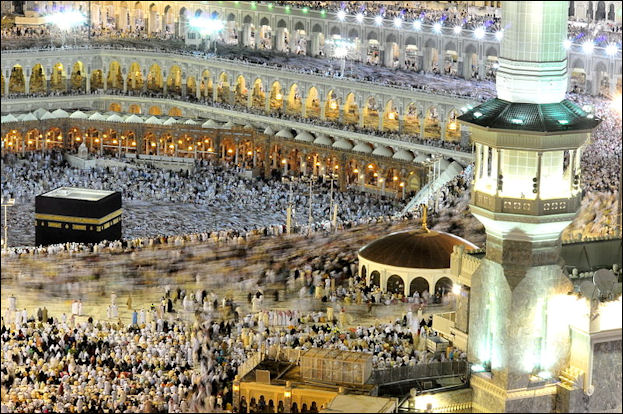
Farewell Tawaf around the Kaaba
Image Sources: Al Jazeera English, Wikimedia Commons
Text Sources: Internet Islamic History Sourcebook: sourcebooks.fordham.edu ; Arab News, Jeddah; “Islam, a Short History” by Karen Armstrong; “A History of the Arab Peoples” by Albert Hourani (Faber and Faber, 1991); “World Religions” edited by Geoffrey Parrinder (Facts on File Publications, New York); “Encyclopedia of the World’s Religions” edited by R.C. Zaehner (Barnes & Noble Books, 1959); Metropolitan Museum of Art, Encyclopedia.com, National Geographic, BBC, New York Times, Washington Post, Los Angeles Times, Smithsonian magazine, The Guardian, Al Jazeera, The New Yorker, Time, Newsweek, Reuters, Associated Press, AFP, Library of Congress and various books and other publications.
Last updated April 2024
